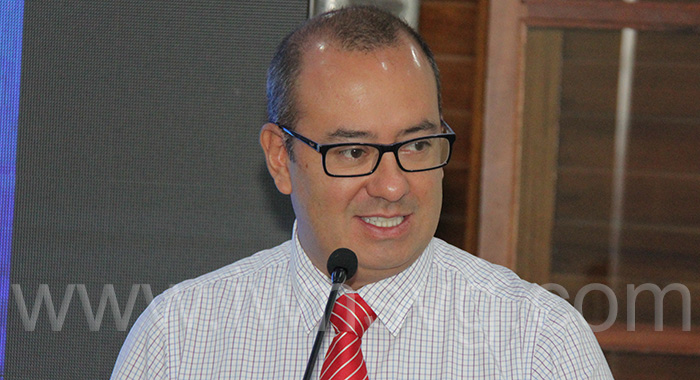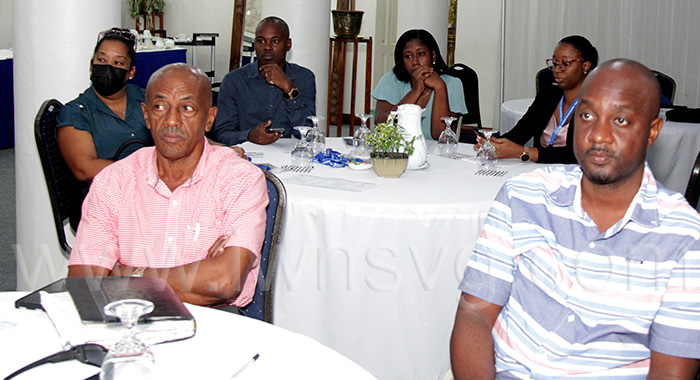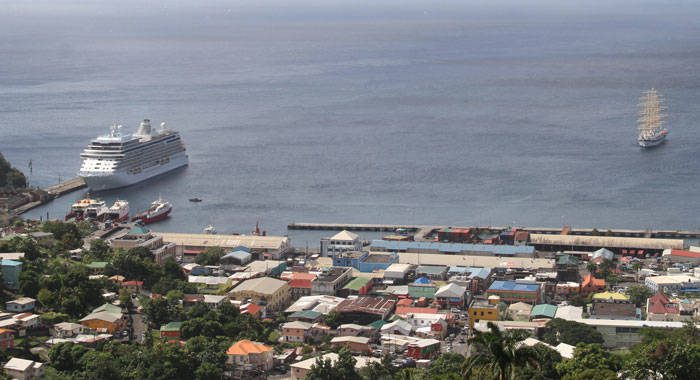As St. Vincent and the Grenadines focuses on the development of a new city at Arnos Vale, a United Nations agency has noted that disaster risk reduction is not solely the responsibility of the National Emergency Management Organisation (NEMO).
Jair Torres, senior consultant to the United Nations Office for Disaster Risk Reduction (UNDRR) office in Panama, told a three-day workshop in Villa last week that NEMO’s role in this regard is to facilitate interaction between all of the actors and the authorities and in the communities.
“But disaster resolution is all-sector approach; it’s everybody’s business,” Torres told the “Making Cities Resilient 2030 (MCR2030)” workshop, held Nov. 9-11 as a collaboration between NEMO and UNDRR
“So, everybody has something to contribute to disaster risk reduction and something to receive from disaster risk reduction,” Torres said.
Making Cities Resilient 2030 (MCR2030) is a unique cross-stakeholder initiative for improving local resilience through advocacy, sharing knowledge and experiences. It also promotes the establishment of mutually reinforcing city-to-city learning networks, injection of technical expertise, connecting multiple layers of government and building partnerships.
“In a way, what NEMO is doing is trying to facilitate what the Ministry of Education, the Ministry of Health, the Ministry of Finance, the Ministry of Planning, the Ministry of Infrastructure, how the office of disaster risk reduction is aligned with this idea of building a more resilient St. Vincent and the Grenadines,” Torres said.
“So, we would like to see that you strengthen cooperation, that you understand that NEMO is here to facilitate that process and that you are key actors really in the development of resilience in the country,” Torres said.
He said what takes place at the local and community level should reflect disaster risk reduction decisions at the national level.
“… the Making Cities Resilient initiative is trying to provide support to different local governments and national governments in order to really articulate what has been decided at the national level with what is happening at the local level,” Torres said.

He said the thinking behind the workshop was to examine how different sectors and entities could extend transversal cooperation and really improve so as to work together at the local level to have a real action plan that will determine how to improve disaster risk reduction and increase resilience in cities.
The ultimate goal of MCR2030 is to ensure that cities become inclusive, safe, resilient and sustainable by 2030.
This will directly contribute to the achievement of the Sustainable Development Goal 11 (SDG11), “Make cities and human settlements inclusive, safe, resilient and sustainable”, and other global frameworks including the Sendai Framework for Disaster Risk Reduction, the Paris Agreement and the New Urban Agenda.
The main objective of the workshop was to expose key stakeholders to the Resilience Roadmap which is a pathway for the Making Cities Resilient 2030 initiative.
This roadmap will assist key stakeholders to understand where their cities are in terms of resilience and the actions that need to be taken to reduce risks, improve resilience, and connect with entities that can support implementation of actions for enhancing resilience.
Torres noted that the Sendai Framework for Disaster Risk Reduction was set up in 2015 and that the global community has different targets it wants to bring together to reach a more resilient society by 2030.
These include strategies about reducing mortality, reducing the negative effects on infrastructure and basic service, reducing the impacts of economic losses, increasing cooperation, increasing early warning systems, and a specific target concerning the needs at the national level to create strategies for disaster risk reduction.
“So, it’s how we create these strategies that will allow us to understand who has the roles and responsibilities, how we finance these strategies, how we govern ourselves for those strategies, and how we monitor and evaluate the way we are implementing those strategies.”

He said that the UNDRR’s efforts at the workshop align with the support that that UNDRR is providing to St. Vincent and the Grenadines in terms of improving risk knowledge, improving data, improving how information is collected and used for decision-making, for policy-design, for investments that are resilient, but as well for transitioning from traditional early warning systems to impact-based forecasting.
“We really hope that the outcomes … from these three days will be really concretised in an action plan, that you feel really your different agencies have reflected in that action plan,” Torres said.
He said that the Caribbean is a priority region for UNDRR to the extent that an office will be opened in Barbados, as having a more significant presence in the region is a main goal for the UNDRR’s hemispheric office.
Another of the main priorities of the MCR2030 team within the United Nations Office is working in the Caribbean region to try to strengthen the resilience of local communities and local corporations.
“Through MCR, you’re gonna see a lot of partnership between local authorities, within those local authorities, but MCR is also a partnership between different local communities all around the world,” Torres said.
He said that within the Caribbean, Jamaica, Tobago and the Dominican Republic are already part of the MCR 2030 and UNDRR is working to get a network of different cities that are working on building resilience all around the world with different countries and different cities that are aligned to the initiatives.
“So, we think that St. Vincent and the Grenadines is very well placed to be part of this specific network of cities,” he said, noting the country’s experience over the last two years dealing with the dengue epidemic, the COVID-19 pandemic, the eruption La Soufriere volcano, the impacts of the Hurricane Elsa and some social hazards.
“It is really a demonstration that St. Vincent and the Grenadines is prepared to work together, to be agile in legislation, to be agile in implementation of actions and policy. And we believe that St. Vincent and the Grenadines is ready to be part of this big network of countries and cities that are really bringing resilience to another level,” Torres said.

Meanwhile, Hudson Nedd, permanent secretary in the Ministry of National Security, said that while the emphasis is on Arnos Vale, within recent times, there has been “this sprawl of commercial development across the landscape of the southern sector of St. Vincent”.
Nedd said that while a city in St. Vincent and the Grenadines cannot boast of the population size of, say, Miami, when scaled, there is similar migration to Kingstown, the capital, and its suburbs over the last three decades.
He said this has put significant pressure on small geographic space.
“… and so, we could consider it as a permanent and densely settled place, with a defined administrative boundary. Sometimes it overlaps with different ministries having different responsibilities, but whose members primarily work on non-agricultural tasks,” Nedd said, citing the definition of a city.
“This seems to be relevant in the context of St. Vincent,” he said, adding that a city is an extensive system for housing, transportation, sanitation, utilities, land use, production of goods and communication.
“Their density facilitates interaction between people, government, organisations and businesses. Right away, we get this sense that a lot of variant interests come together in a small geographical area and interact in a manner that really ought to support the sustainability of each other. Each has their own focus, but each is interlinked and dependent on the model.”
Nedd said resilience speaks to a measure of persistence of systems and the ability to absorb change that may occur and disturbance and still maintain generally the same relationships between the population and all those other variables that I mentioned.
“So, it is important that when we come together with varying focus, we speak frankly about the issues of risk that affect us in our various sectors and we come up with strategies to manage those risks. I said earlier that there’s really no natural disaster. What we have are several events, environmental and natural events that have been occurring as far back as we know,” he said.






